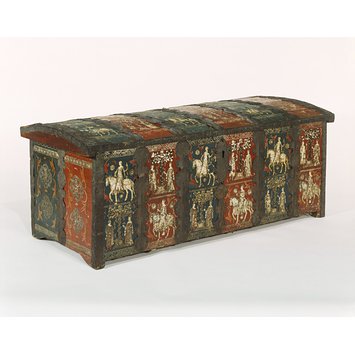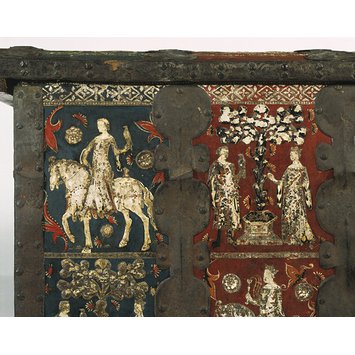
Cassone, c. 1345 – 1354 (made), Florence or Siena, Italy. Currently held by the Victoria & Albert Museum, London.
A cassone, or marriage chest, was an important part of a girl’s bedroom. Telling a story of romance and beautifully decorated, this cassone was made between 1345 and 1354, and was a high status symbol for rich merchants and aristocrats in Italy. It was also one of the most important pieces of furniture on display in the home, typically in the bridal suite.
A girl was given the cassone during her wedding, as a gift from her parents. Since it was for marriage, the cassone was decorated with painted panels commemorating marriage or allegorically referring to love. The one shown here was most likely made in Florence or Siena, since we have records of similar cassoni ordered by Francesco Datini in 1384 and painted by Simone Martini (d. 1344).
When I think about girlhood, or at least the western stereotype of girlhood, I think of bedrooms like the one this cassone would have been in. The stereotype of boyband posters, mess, and individuality. What a One Direction poster was to a girl of the 2000s, the cassone was to a girl of the 1300s. Typically, cassoni were placed around the bed, for decoration and functionality, but also to remind a young girl of her duties as a new bride and the love she should hold for her husband.
The Geffrye Museum in London held an exhibition about the importance of girls’ bedrooms, on display until June 4, 2017. The exhibition is described as
“a rare glimpse into the often secret, out-of-bounds world of the teenage bedroom.” Guest curator Carey Newson and photographer Kyna Gourley documented the bedrooms of 26 London teenagers revealing how identity, memory and friendship are expressed within these eclectic private spaces and highlighting the contradictions of a room that is both within the family home and a space apart.”
That teenage girls have had specific decorations in their bedrooms since the medieval period is telling. While today bedroom decorations are highly individualized and chosen by the girl, the cassone reveals that a girl’s identity in middle to upper class Italy was largely dictated by her parents. It was also defined by her role in society: wife (and later mother). The most expensive and prominent piece in her bedroom suite, the cassone was a constant reminder of her duties in love and marriage.

Detail of the Cassone, c. 1345 – 1354 (made), Florence or Siena, Italy. Currently held by the Victoria & Albert Museum, London.
That brings us to my second thought: girlhood romance. This cassone, like many others, is decorated with popular romantic themes of the time: a pair of figures are standing by the “fountain of love” while another lady rides horseback with a falcon as she takes part in the “hunt of love.” The second symbol has an unexpected symbolism. In medieval Italy, the falcon was a symbol of sexual aggressiveness. And if you look closely, you’ll see the lady is also holding a whip. Taken together, the images are symbolic of a lady spurring on her lover and inflaming his ardor – in other words, making sure that sexual desire was a prominent part of her marriage.
Much like the typical girlhood connection with Disney today, the cassone tells a story of romance and takes centre stage in a girl’s bedroom. However, unlike many Disney stories, the cassone shows the girl taking on a more prominent role in her marriage. She is empowered in attracting and having sexual relations with her husband. Unlike the stereotypes of medieval women as submissive or passive, the symbolism on this cassone paints a picture of a young bride as active in engaging her husband through flirtation and sex. She is more empowered in their romance that history might have led us to believe. That’s quite a message for a girl’s parents to give her on her wedding day!
The cassone takes pride of place in the Victoria and Albert Museum’s Medieval and Renaissance gallery today, both for its beauty and for its social history storytelling. The cassone reveals an insight into Medieval Italian culture, a sneak peak into the historical equivalent of the teenage bedroom, that leaves us wanting to know more about what really happened in those bedrooms.
-Chloe Turner
Junior Girl
Girl Museum Inc.
This post is part of our 52 Objects in the History of Girlhood exhibition. Each week during 2017, we explore a historical object and its relation to girls’ history. Stay tuned to discover the incredible history of girls, and be sure to visit the complete exhibition to discover the integral role girls have played since the dawn of time.
